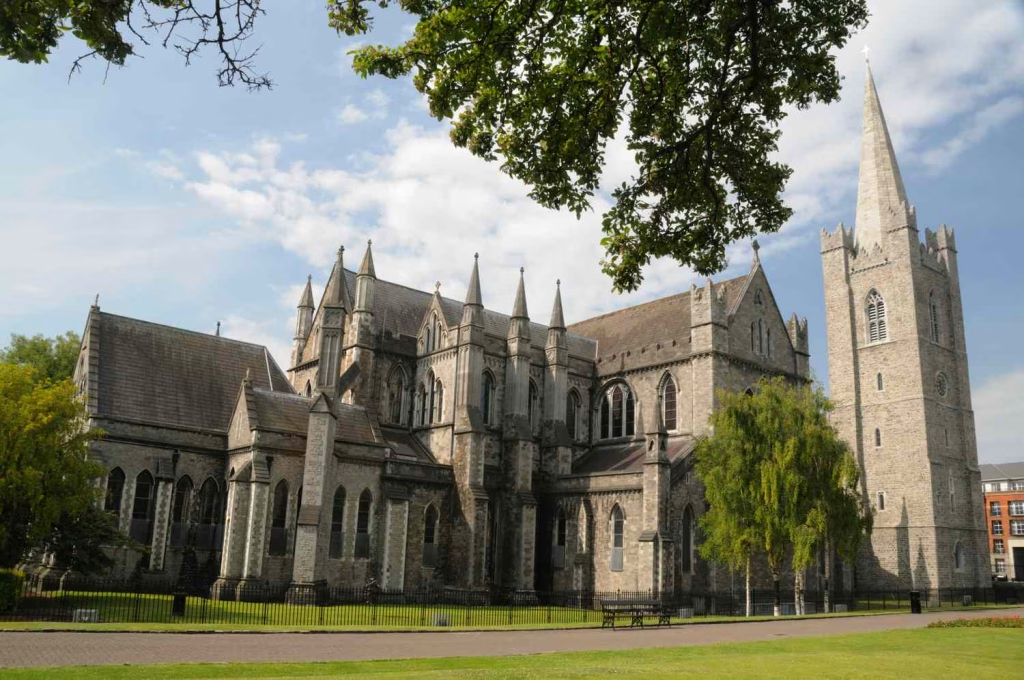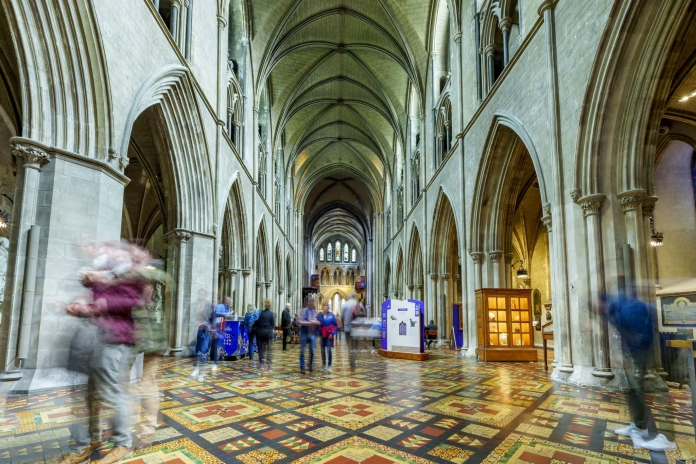St Patrick’s Cathedral
Right in the heart of Dublin, St. Patrick’s Cathedral stands as a beacon of Ireland’s rich history and architectural grandeur. Whether you’re a history buff, an architecture enthusiast, or simply a curious traveler, this iconic landmark offers an important journey through time. In this guide, we’ll take you through everything you need to know about St. Patrick’s Cathedral, including its fascinating history, what to expect during your visit, and how to get there.
A Brief History of St. Patrick’s Cathedral
St. Patrick’s Cathedral, also known as the National Cathedral and Collegiate Church of Saint Patrick, Dublin, was founded in 1191. It is one of the few buildings left from the medieval period in Dublin. The cathedral is built on the site where it is believed that St. Patrick himself baptised converts to Christianity in the 5th century.
Over the centuries, the cathedral has undergone numerous restorations and has played a pivotal role in Ireland’s religious and cultural life. In the late 19th century, a major restoration funded by Sir Benjamin Lee Guinness, of the famed Guinness brewing family, ensured the cathedral’s preservation for future generations. This Gothic-style masterpiece is now a symbol of Irish resilience and faith.
Exploring St. Patrick’s Cathedral: What to See
1. The Nave and Choir: The nave, with its soaring ceilings and intricately carved stonework, is an imposing sight. The choir, adorned with medieval decorations, offers a glimpse into the artistic craftsmanship of the past.
2. Jonathan Swift’s Final Resting Place: The renowned author of “Gulliver’s Travels” and former Dean of the Cathedral, Jonathan Swift, is buried here. His grave, along with that of his longtime companion Esther Johnson (Stella), is a reminder of his contributions to literature and the church.
3. The Lady Chapel: Located at the eastern end of the cathedral, the Lady Chapel dates back to 1270. It has been beautifully restored and is often used for quiet reflection and smaller services.
4. The St. Patrick’s Park: Adjacent to the cathedral, St. Patrick’s Park is a tranquil green space perfect for a leisurely stroll or a picnic. The park features a charming fountain and commemorative plaques that celebrate Dublin’s rich history.
5. The Door of Reconciliation: One of the most fascinating artifacts in the cathedral is the Door of Reconciliation. This medieval door bears a hole through which two feuding families shook hands and made peace, giving rise to the phrase “to chance your arm.”
Directions to St. Patrick’s Cathedral
St. Patrick’s Cathedral is located in Dublin’s city center, making it easily accessible whether you’re arriving by public transport, car, or on foot.
By Public Transport:
- Bus: Several Dublin Bus routes serve the cathedral area, including routes 49, 54a, and 56a. You can disembark at the St. Patrick’s Cathedral stop.
- LUAS (Light Rail): The nearest LUAS stop is St. Stephen’s Green, from where it’s a pleasant 10-minute walk to the cathedral.
By Car:
- If you’re driving, you can use the following address for your GPS: St Patrick’s Close, Dublin 8, Ireland. There are several car parks in the vicinity, including the Q-Park Christchurch and St. Stephen’s Green car park.
On Foot:
- For those staying in or near the city center, walking to St. Patrick’s Cathedral is an accessible option. From Grafton Street, for example, it’s about a 15-minute walk. Simply head south on Grafton Street, continue onto Dame Street, and then turn right onto Clanbrassil Street Upper. The cathedral will be on your right.
Ticket Prices and Visiting Hours
St. Patrick’s Cathedral welcomes visitors year-round, but it’s always a good idea to check the official website for any changes in opening hours or special events that might affect your visit.
General Admission Prices:
- Adults: €10.00
- Students/Seniors: €9.00
- Children (aged 6-12): €4.50
- Family Ticket (2 adults + 2 children): €28.00
- Children under 6: Free
Opening Hours:
- Monday to Friday: 9:30 AM – 5:00 PM and 6:15 PM to 7:15 PM
- Saturday: 9:00 AM – 6:00 PM
- Sunday: 9:00 AM – 10:30 AM, 1:00 PM – 2:30 PM, 4:40 PM – 6:00 PM
Please note that these times may vary, especially during special services or events, so it’s wise to verify before your visit. Group rates are also available.
For more see: stpatrickscathedral.ie
Tips for Your Visit
1. Arrive Early: To fully appreciate the beauty and serenity of the cathedral, try to arrive early in the day. This way, you can avoid the larger crowds and enjoy a more peaceful experience.
2. Join a Guided Tour: While you can certainly explore the cathedral on your own, joining a guided tour can enhance your visit. Knowledgeable guides share intriguing stories and insights that bring the history and significance of the cathedral to life.
3. Don’t Miss the Gift Shop: The cathedral’s gift shop offers a variety of souvenirs, including books, postcards, and unique Irish crafts. It’s a great place to pick up a memento of your visit.
4. Respect the Sacred Space: Remember that St. Patrick’s Cathedral is an active place of worship. Be mindful of services and other activities taking place during your visit. Silence your phone and speak in hushed tones to maintain the reverent atmosphere.
The Importance of St. Patrick’s Cathedral in Dublin’s Heritage
St. Patrick’s Cathedral is more than just a historical site; it is a living testament to Dublin’s evolving identity. It has stood the test of time, bearing witness to centuries of change and continuing to serve as a place of worship, reflection, and community gathering.
The cathedral’s role in fostering peace and reconciliation is also noteworthy. The Door of Reconciliation, with its story of feuding families making peace, is a powerful symbol of the cathedral’s enduring message of unity and forgiveness.
Moreover, the cathedral hosts numerous concerts, exhibitions, and educational programs throughout the year, contributing to Dublin’s vibrant cultural landscape. These events draw both locals and tourists, highlighting the cathedral’s importance as a cultural and spiritual hub.
Nearby Attractions
While visiting St. Patrick’s Cathedral, you might want to explore other nearby attractions to make the most of your trip to Dublin.
1. Christ Church Cathedral: Just a short walk away, Christ Church Cathedral is another stunning example of Dublin’s medieval architecture. Its crypt, one of the largest in the Europe, is a must-see.
2. Dublin Castle: A symbol of British rule until 1922, Dublin Castle is now a major government complex and tourist attraction. Explore its State Apartments, gardens, and the Chester Beatty Library, which houses an impressive collection of manuscripts and artworks.
3. Temple Bar: Known for its lively nightlife, Temple Bar is also home to cultural institutions like the Irish Film Institute and the Gallery of Photography. Enjoy a meal or a pint in one of the many traditional pubs.
4. Guinness Storehouse: A visit to Dublin wouldn’t be complete without a tour of the Guinness Storehouse. Learn about the history of Ireland’s most famous beer and enjoy a pint with panoramic views of the city from the Gravity Bar.

Final Thoughts
St. Patrick’s Cathedral is a jewel in Dublin’s crown, offering a unique blend of historical depth, architectural beauty, and spiritual solace. Whether you’re exploring its stunning nave, reflecting in the tranquil Lady Chapel, or learning about Jonathan Swift’s legacy, the cathedral provides a deeply enriching experience.
Its central location makes it an easy addition to any Dublin itinerary, and with affordable admission prices, it’s accessible to everyone. So, whether you’re a first-time visitor or a seasoned traveler, make sure St. Patrick’s Cathedral is on your must-visit list when you explore the vibrant and historic city of Dublin.


